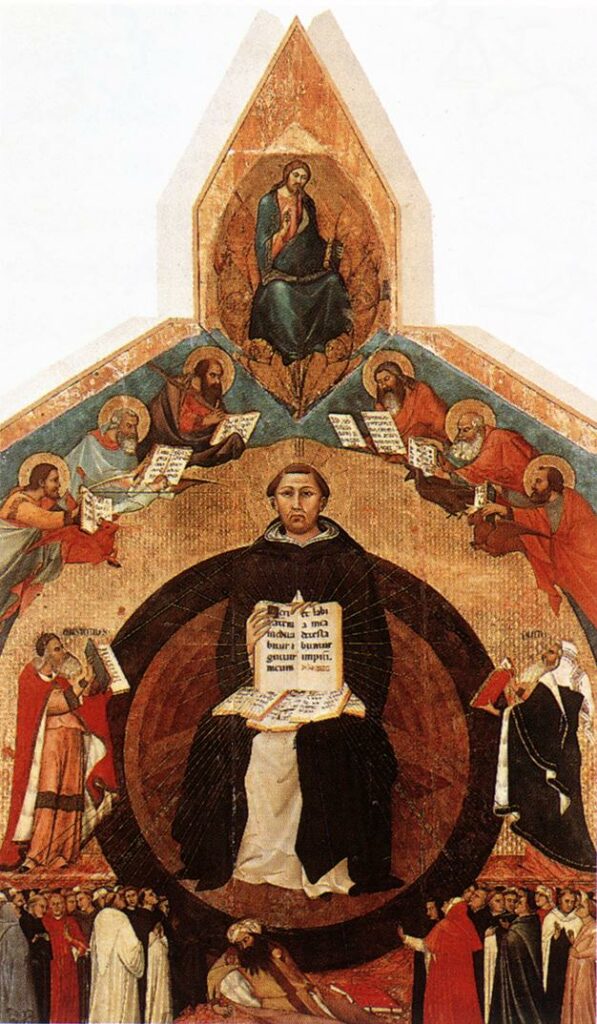Medieval Thinking
― Thomas Aquinas in De Regno (On Kingship)
The rise and fall of Rome follows the golden age of Ancient Greece. Greek philosophical traditions underwent assorted transformations during this period, but Rome is not known for making significant original contributions to either philosophy or science. Intellectual progress requires a degree of liberty that was not as available in the Roman Empire. Additionally, the intellectual talent and energy available in ancient Rome would have been almost fully occupied with the demands of expanding and sustaining political power and order. Rome had more use for engineers and bureaucrats than scientists and philosophers.
Christianity became the dominate religion in Rome after emperor Constantine converted in the 4th century CE. Also in the 4th century, the great Christian philosopher Augustine, under the influence of Plato, formulated much of what would become orthodox Catholic doctrine. After a rather dissolute and free-wheeling youth, Augustine studied Plato and found much to make Christianity reasonable in it. With the rise of the Catholic Church, learning and inquiry were pursued almost exclusively in the service of religion for well over a millennium. Philosophy in this period is often described as the handmaiden of theology. The relationship between philosophy and theology is perhaps a bit more ambiguous, though. As we have just noted in the case of Augustine, much of Ancient Greek philosophy gets infused into Catholic orthodoxy. But at the same time, the new faith of Christianity spearheads an anti-intellectual movement in which libraries are destroyed and most Ancient Greek thought is lost to the world forever.
Through the West’s period of Catholic orthodoxy, most of what we know of Greek science and philosophy, most notably Aristotle’s thought, survived in the Islamic world. Islamic philosophy flourished from the 9th century onwards, with Al-Kindi, until the 12th century CE, with Ibn-Rushd. This golden age of Islamic philosophy (or falsafa) was precipitated by the spread of Islam and brought about conditions that fostered new ideas. There was now a multicultural empire that stretched from Iberia (modern day Portugal and Spain) and North Africa to the western parts of Ancient India (what is now Afghanistan). People now had a common lingua franca: Arabic. Greek philosophical texts (including Plato and Aristotle) as well as Indian Sanskrit books on mathematics were translated into Arabic and studied by scholars. This is how Indian mathematics and the Indian number system (modern numerals) came to Europe.
The immense contribution of Islamic scholars to the preservation of Ancient Greek and Indian thought cannot be overstated. Eventually, Arabic texts were translated into Latin and studied by Christian monks and scholars. This brought Aristotle’s ideas back into the West, while at the same time, they withered in the Islamic worlds as orthodoxy set in. Al-Ghazali’s work Tahafut al-Falasifa (The Incoherence of the Philosophers) criticized philosophy and directed people towards mysticism and religious orthodoxy. Ibn-Rushd’s books were burned by his fellow Muslims and the Islamic world plunged into a dark age from which some parts have yet to emerge.
At the same time, Aristotle’s views about the natural world quickly came to be received as the established truth in the Christian world. Aristotle’s physics, for instance, became the standard scientific view about the natural world in Europe. Aristotle also wrote about the methods of science and was much more empirical than his teacher, Plato. Aristotle thought the way to learn about the natural world was to make careful observations and infer general principles from them. For instance, as an early biologist, Aristotle dissected hundreds of species of animals to learn about anatomy and physiology.
Scholasticism was a medieval school of philosophy that emerged within the monastic schools. They translated Judaic and Islamic texts into Latin and, in some sense, rediscovered Ancient Greek thought. Their aim was not understanding the universe per se, but rather to harmonise Aristotle’s metaphysical ideas with Christian theology. The Scholastics who studied Aristotle obviously did not adopt the methods Aristotle recommended. The scholastics emphasised dialectical reasoning to extend knowledge by inference and resolve contradictions rather than rely on empirical observations. But some other people disagreed. Galileo, Leonardo da Vinci, and Copernicus were among the few brave souls to turn a critical eye to the natural world itself and, employing methods Aristotle would have approved of, began to challenge the views of Aristotle that the Scholastics had made a matter of doctrine. Thus begins the Scientific Revolution.

This does not mean that Europe evolved into a new society. Religion and superstition were still the norm. Heretics were regularly tortured and burned alive for going against church teachings. Giordano Bruno was famously burned alive by the Catholic Church for speculating on the existence of exoplanets (planets orbiting other stars). Galileo Galilei was placed under house arrest for the rest of his life for claiming that the Earth orbited the sun. However, seeds of knowledge had been planted, and a renaissance in thought was starting to emerge.
Media Attributions
- Figure 1.9 Lippo Memmi – Triumph of St Thomas Aquinas – WGA15020 by Lippo Memmi (1291–1356) [Photo from the Web Gallery of Art], via Wikimedia Commons, is in the public domain.

